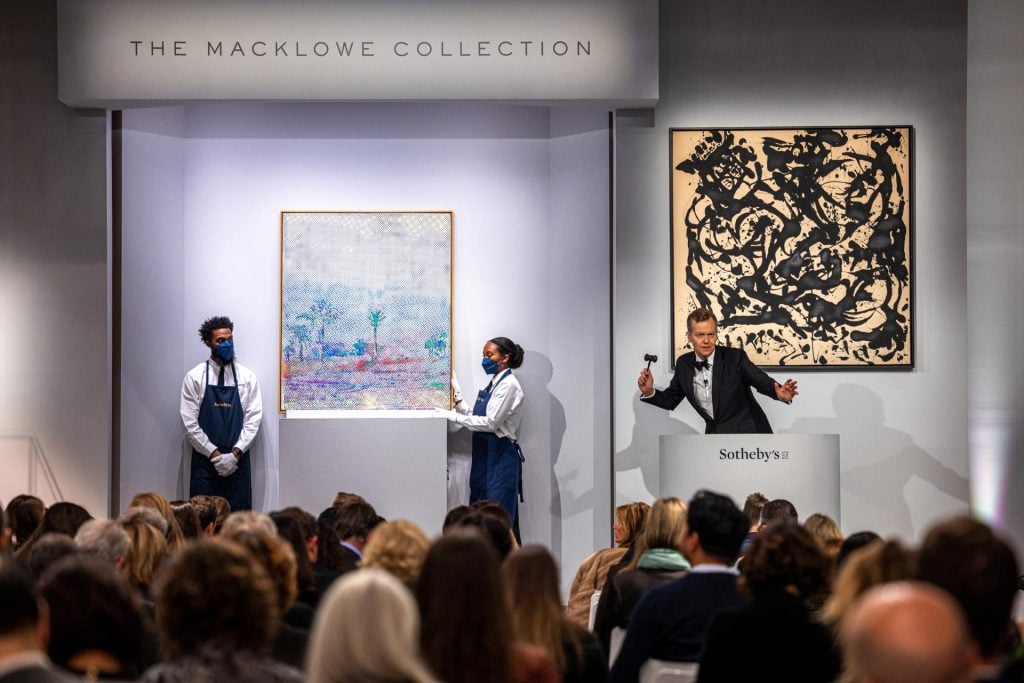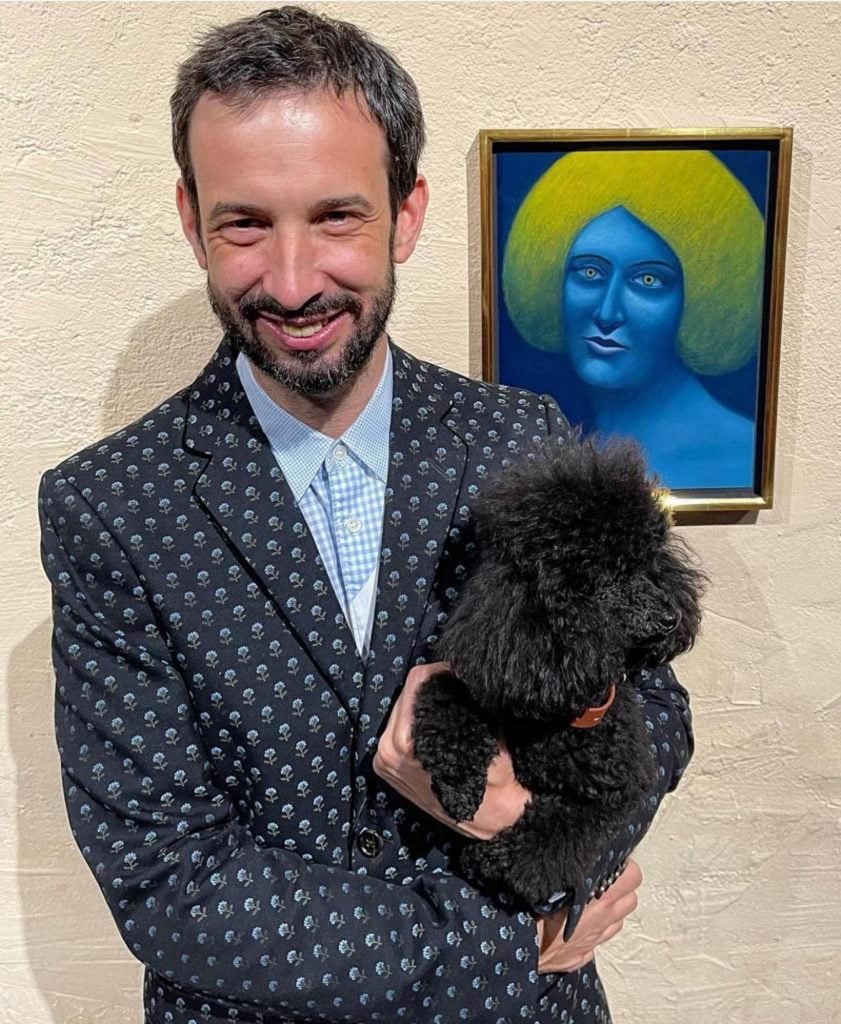The Hammer
Simon de Pury Has Presided Over Hundreds of Auctions. Here’s His Take on What the New York Sales Tell Us About the Future
The rapid rise of this season's auction stars show how today’s market tastes are changing faster than ever.

The rapid rise of this season's auction stars show how today’s market tastes are changing faster than ever.

Simon de Pury

Every month in The Hammer, art-industry veteran Simon de Pury lifts the curtain on his life as the ultimate art-world insider, his brushes with celebrity, and his invaluable insight into the inner workings of the art market.
It was invigorating to travel this fall to Los Angeles and New York (for the first time since early 2020), and to London. In all three places the energy was stronger and more vibrant than it was before the pandemic. Despite—or because of—the massive digital strides the art world has made since the beginning of Covid, it was sheer magic to experience artworks in the flesh, whether it was in museums, auction houses, or commercial galleries.
The results of the November auctions at Sotheby’s, Christie’s, and Phillips in New York were impressive. The fall season demonstrated once more that when there are major single owner collections or estates, these act as locomotives that pull the whole rest of the market.
Conducting big evening sales back in the ‘80s, ‘90s, or early ‘00s required nerves of steel since only a relatively small number of top lots were protected by guarantees. Since then, most lots above $10 million are either covered by third party guarantees or pre-sold to irrevocable bids. On the evening of the auction there is therefore no longer the nerve-racking suspense to know if they will sell at all. The success of the Macklowe Collection was a tribute to the exceptional sense for quality of its former owners.

The Macklowe Collection sale. Photo courtesy of Sotheby’s.
The main conclusion from this latest round of sales is that the market is by far the most buoyant for artists whom until quite recently you could acquire at considerably lower prices on the primary market. “Could,” that is, if you were chosen by the gallery as being worthy of owning a work for which there were long waiting lists. In most cases it is the gallery owner representing the artist who picks which work should go to which collector and not the other way round.
In a hypothetical exhibition of 20 new works of a given artist, all executed during the same year and all of the same size, the gallery will charge the same price for each work they sell to the selected clients they view as strategically important. The reality is, however, that among those 20 works there will be two or three that everybody desperately wants. The lucky few “pure” collectors who will have been handpicked for these most desirable works will invariably want to discreetly assess what these works potentially could fetch if offered at auction.
That is one explanation for the big spikes in prices one has seen for artists such as Nicolas Party. Over the last 18 months his prices had already climbed extra fast, fueled by interest from Asian buyers. The estimates for Party’s Houses of 2015 at Phillips of $400,000 to $600,000 and of Party’s Landscape of 2021 at Christie’s of $300,000 to $500,000 could even be viewed as fairly stiff. They totally pale in comparison to the prices they actually obtained of $1,724,000 and $3,270,000, respectively. Financially speaking, the winners were the ones who had succeeded in gaining the gallery’s initial favor. Ironically, the artists and the gallery were the ones losing out on the massive gains obtained in a very short time span. It is for that reason that in an earlier edition of The Hammer I had expressed my surprise that none of the top galleries were doing auctions for their most in-demand primary market artists.

Nicolas Party with his work at the Swiss Institute. Photo by Simon de Pury.
On November 14 I conducted the annual benefit auction for the Swiss Institute in New York. Under the brilliant leadership of Simon Castets, its director, it has exhibited an impressive list of artists, well before they became red-hot market commodities. Nicolas Party had donated a tiny pastel “Portrait,’” done this year, which carried an estimate of $75,000. In a rapid succession of bids coming from all over the room, but also over the internet and the phone, the price climbed to $420,000.
Hilary Pecis is another case in point. Less than a year ago, you could acquire her works for $20,000—again only if the gallery were prepared to sell it to you and not to someone else they considered more important. On November 9, Christie’s offered Pecis’s beautiful Upstairs Interior (2019) with an estimate of $60,000 to $80,000, which sold for over ten times the estimate at $870,000. For an artist whose work had not appeared at auction before October 2020 (a painting that made $68,000 at Sotheby’s Hong Kong), this was a remarkably swift ascension. The totality of the 12 other works by Pecis that were sold at auction (at the time of writing this article) made $8,470,794. This is an impressive number for a newcomer to the secondary market, especially if you bear in mind that the vast majority of these works were sold during the second half of 2021.
The prices for works by artists of color and female artists have been climbing at a fast pace these last three years, and are only just beginning to correct a longstanding injustice. Five years ago I was asked, in Dallas, to choose eight works out of an exhibition of around 60 paintings, that I would sell during the dinner of the MTV Staying Alive charity organized by the Michael Goss Foundation. I picked the works that I thought would allow me to raise the maximum price to help the invaluable work done by the foundation in relation to finding a way to eradicate AIDS.
After the auction, a lady approached me angrily saying that I was a “male chauvinist pig” having only included two female artists in the live auction of eight works. When I gave her the rationale behind my choice she was even more agitated. In hindsight I understand her, and am glad that the art world as a whole and the art market in particular have finally begun to correct this.
1-54, the Contemporary African African art fair that was started eight years ago by Touria El Glaoui has been right from the start one of the art fairs that I most enjoy visiting. The originality, freshness and quality of a lot of work coming from the African continent is exciting. Benjamin Kwaku Boateng, a Ghanaian British art dealer and advisor, has been a key protagonist behind the scenes, early on championing the works of artists such as Amoako Boafo, Emmanuel Taku, and Cinga Samson. This season again he demonstrated his skills in spotting talents early. Contemporary art has gone from strength to strength. Kwesi Botchway and Wahab Saheed, whose works he first brought to the attention of private collectors some time ago, both had their auction debuts with works selling respectively for $214,200 and $81,900 at Phillips.
The obsessive fear of missing the next train that will depart is stronger than ever before. There doesn’t seem to be much of a memory in many active collectors and market professionals. Waves have a tendency to build momentum but eventually they all come crashing down. A few artists always remain when everyone focuses on the next wave but they are in the clear minority. A clear acceleration in the general taste is taking place. Having just recovered from celebrating my 70th birthday, I would like to devote my next column to the evolution of taste during my 50 years in the market.
Simon de Pury is the former chairman and chief auctioneer of Phillips de Pury & Company and is a private dealer, art advisor, photographer, and DJ. Instagram: @simondepury